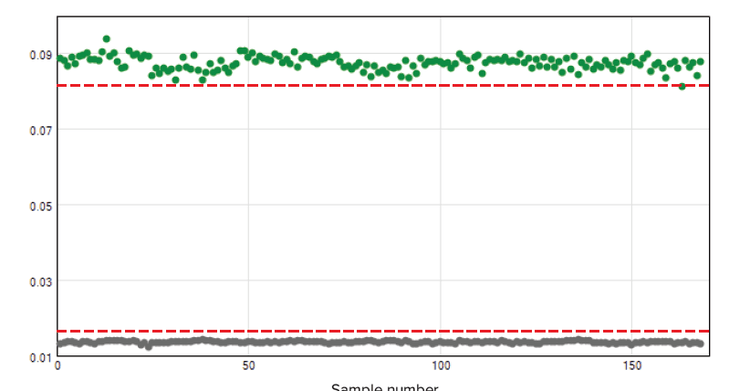
Application Note
Homogeneous, high-throughput epigenetics assay on SpectraMax Microplate Readers
- Z’ factor of 0.91 indicates a robust screening assay
- Homogeneous assay is amenable to miniaturization
- Time-resolved detection minimizes background and compound interference
Introduction
Epigenetics involves changes in gene expression that are stable between cell divisions and may be heritable between generations but do not alter the DNA sequence itself. Epigenetics controls many essential facets of an organism, and its involvement in stem cell function and cancer is an active area of investigation.
Many epigenetic studies focus on the interaction of histones and their associated proteins1. Acetylation of histone lysine residues is critical to epigenetic regulation of gene transcription. Acetylated histones are recognized and bound by proteins through a small protein domain known as a bromodomain. One such protein is BRD4, a member of the BET family of proteins, whose members are involved in inflammation, gene expression, mitosis, and other cellular processes2. Small molecule inhibitors of bromodomain/histone interactions offer potential as therapeutics for human disease3.
Cayman Chemical’s BRD4 bromodomain 1 (BRD4-B1) kit uses time-resolved fluorescence resonance energy transfer (TR-FRET) to rapidly characterize inhibitors of the bromodomain/acetylated peptide interaction (Figure 1). The TR-FRET donor is a Eu3+ chelate-labeled BRD4-B1 protein, which binds to a biotinylated peptide ligand. The TR-FRET acceptor consists of allophycocyanin (APC)-labeled avidin bound to the peptide ligand via the biotin moiety. Disruption of the BRD4-B1/ligand interaction, e.g. by an inhibitor compound, causes a loss of TR-FRET signal. The use of time-resolved detection offers an increased signal-to-noise ratio and minimizes the effects of compound fluorescence, making TR-FRET assays especially useful for high-throughput screening applications. In this application note, we use the BRD4 bromodomain 1 TR-FRET Assay Kit in combination with SpectraMax Multi-Mode Microplate Readers to obtain IC50 data using a known inhibitor of BRD4. The Z’ factor was 0.91, making it a robust assay for screening4.

Figure 1. Assay schematic for the BRD4 bromodomain 1 TR-FRET Assay Kit. Upon excitation, the europium chelate can release a photon or transfer its energy to APC, provided the APC is in close proximity to europium.
Materials
- BRD4 bromodomain 1 TR-FRET Assay Kit (Cayman Chemicals cat. #600520)
- JQ-1 (+) inhibitor (Cayman Chemicals cat.#11187)
- 384-well low-volume solid black plate (Cayman Chemicals cat. #400093)
- Dimethyl sulfoxide (DMSO, Sigma cat. #D8418)
- SpectraMax® i3 Multi-Mode Microplate Reader (Molecular Devices)
- SpectraMax® Paradigm® Multi-Mode Microplate Reader (Molecular Devices)
- SpectraMax® M5e Multi-Mode Microplate Reader (Molecular Devices)
Assay setup and detection
The BRD4 bromodomain 1 TR-FRET assay was performed as described in the assay kit manual. A two-fold dilution series of JQ1 (in DMSO) starting from 1 μM was prepared. The assay was set up in a low-volume 384- well black plate using the pipetting scheme and volumes shown in Table 1. After a one-hour incubation at room temperature, the plate was read on the SpectraMax i3 reader using the optimized settings shown in Table 2, as well as on the SpectraMax Paradigm reader and the SpectraMax M5e reader. On the SpectraMax i3 and SpectraMax Paradigm readers, microplate optimization was performed to ensure precise readings from the center of each well.
Table 1. Pipetting scheme for the bromodomain TR-FRET Assay Kit.
Table 2. Optimized instrument settings for SpectraMax i3 and SpectraMax Paradigm readers. The detection cartridge includes excitation light source and optics as indicated. Similar wavelength, delay, and integration settings were used for the SpectraMax M5 reader, which has onboard time-resolved fluorescence detection.
In a separate experiment, 168 replicates each of vehicle control and 10 μM (+)-JQ1 inhibitor control were run in order to calculate the Z’ factor. The vehicle control contained assay buffer with 8% DMSO to match the assay conditions of the inhibitor. Z’ factor was calculated as described previously4.
Results
Robust results were obtained on all three SpectraMax readers tested. A representative inhibition curve for (+)-JQ1 detected using the SpectraMax i3 reader is shown in Figure 2. The data were fit to a 4-parameter logistic equation in SoftMax® Pro Software to calculate an IC50 value of 111 nM, which is consistent with the value of 77 nM stated in the assay kit manual. The calculated Z’ factor as shown in Figure 3 was 0.91, making this an excellent assay for high-throughput screening.

Figure 2. Inhibitor response curve of BRD4-BR1 treated with decreasing concentrations of JQ1(+) control (IC50 = 111 nM).

Figure 3. Typical Z’ factor data for the BRD4 bromodomain 1 TR-FRET Assay Kit. (+)-JQ1 control wells contained 10 μM inhibitor, and vehicle control wells contained assay buffer with 8% DMSO. The calculated Z’ factor from this experiment was 0.91. Dashed red lines correspond to three standard deviations from the mean for each control value.
Conclusion
The BRD4 bromodomain 1 TR-FRET Assay Kit, in combination with SpectraMax readers, provides a sensitive, reliable solution for screening inhibitors of the interaction between bromodomain and acetylated peptide that is responsible for normal mitosis and DNA replication. This assay offers researchers a useful tool for the discovery of new therapeutic agents in the increasingly important field of epigenetics.
References
- DeAngelis JT, Farrington WJ, Tollefsbol TO. An overview of epigenetic assays. Molecular Biotechnology 38.2 (2008): 179-183.
- Filippakopoulos P, et al. Selective inhibition of BET bromodomains. Nature 468.7327 (2010): 1067-1073.
- Dimond PF. Epigenetics targets may enable discovery of novel drugs. Gen Eng. & Biotech. News, 24 Oct. 2013. Web. 30 Jan. 2015
- Zhang JH, Chung TDY, Oldenburg KR. 1999. A simple statistical parameter for use in evaluation and validation of high throughput screening assays. J. Biomol. Screening 4.2 (1999): 67-73.